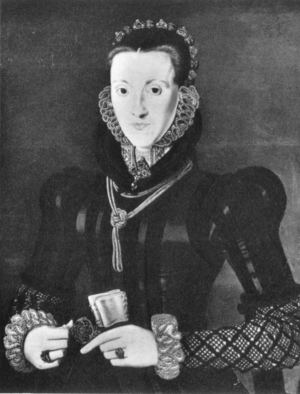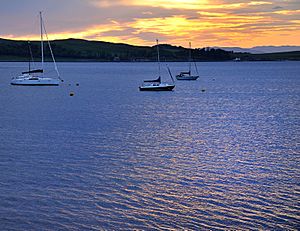Great H of Scotland facts for kids

The Great 'H' of Scotland was a very special jewel. It belonged to Mary, Queen of Scots. This beautiful piece had a large diamond, a ruby, and a gold chain. In 1604, the jewel was taken apart. Its main diamond was then used to create a new famous jewel called the Mirror of Great Britain for James VI and I.
Contents
Mary, Queen of Scots and Her Jewel
This jewel was called the 'H' because of its shape. It was also known as the 'Great Harry'. We know about it from a list of Mary's jewels made in France in the 1550s. This list described it as a French crown jewel. It mentioned a big diamond shaped like a lozenge, which formed the bar of the 'H'. Below it hung a large, smooth ruby.
Mary might have worn this jewel at her wedding in 1558. People said it was "incalculable value," meaning it was worth a huge amount. Later lists in Scotland also talked about the big diamond, the ruby, and a small gold chain. Mary was allowed to keep this precious jewel after her husband, Francis II of France, died. She brought it with her to Scotland. In 1578, it was described as: "The jewel called the great Harry with the letter H containing a great diamond and a great ruby."
The jewel's name suggests it might have been a gift from Henri II of France. A similar jewel was listed in French crown jewels in 1551. Some people thought the Great H was a gift from Henry VII of England to Margaret Tudor. She was the mother of James V of Scotland. Mary's father, James V, owned a different 'H' jewel. It was a hat badge with a ruby. This might have been a gift from Henry VIII of England.
Mary hoped the "Great H" would become part of Scotland's crown jewels. She wanted it to be a lasting memory of her time as queen. She wrote this wish in 1566. She also left a smaller gold "H" jewel to Henry Stuart, Lord Darnley. This one had a ruby and a pearl.
The Jewel's Journey: Regents and Nobles
After Mary gave up her throne, her half-brother, Regent Moray, took the jewel to England. A regent is someone who rules a country when the king or queen is too young or unable to rule. Regent Moray hoped to sell the jewel. His helper, Nicolas Elphinstone, sold Mary's pearls to Queen Elizabeth.
After Regent Moray was killed, his wife, Agnes Keith, Countess of Moray, kept the "H" for several years. Many people wanted the jewel back. Mary, Queen of Scots, asked for it. So did her agent, the Earl of Huntly. Other regents like Regent Lennox and Regent Morton also tried to get it. Both sides in the Marian Civil War wanted the "H" and other jewels.
Agnes Keith wrote a letter in 1570. She asked William Cecil to help her. She wanted Queen Elizabeth to stop Mary from bothering her about the jewels. Agnes said she didn't know at first that the jewels belonged to Mary. She also wanted Elizabeth to ask Regent Lennox not to take the jewels. Agnes later said the jewels' value was fair payment for her husband's costs as Regent. Finally, she gave the "H" back to Regent Morton on March 5, 1575. The list of returned jewels mentioned the "H called the great Harry" with other diamonds and rubies.
Esmé Stewart and James Stewart
When King James VI became an adult in 1581, he gave some of his mother's jewels to his friend, Esmé Stewart, 1st Duke of Lennox. This included the Great H. The jewel was described as: "the great Harry with the letter H containing a great diamond and a great ruby." Lennox returned the jewels when he left for France in 1583.
In 1585, another royal friend, James Stewart, Earl of Arran, was said to have royal jewels. He was on a boat near Ayr. But he was forced to give his treasures to Sir William Stewart. This happened on a ship in the water known as the Fairlie Road. Stewart brought the jewel to the King. It was noted that William Stewart had gotten the jewels back. He gave the "H" directly into the "king's own hands." The jewels recovered from the Earl of Arran were formally returned to Scotland's treasurer on February 23, 1586.
King James VI and I
King James VI gave the 'H' to his wife, Anne of Denmark, to wear. This might have been part of a gift of "the greatest part of his jewels" in December 1593. However, in September 1594, King James needed money. He pawned the jewel with a goldsmith named Thomas Foulis. To pawn something means to leave it with someone as a promise to pay back money. He got £12,000 Scots for it. The "H" also had a small gold chain. It was noted that the large diamond was in the center of the "H." Foulis would be paid back with money from Elizabeth I.
King James needed the money for a military trip to northern Scotland. He was going against the Earl of Huntly and the Earl of Erroll. An English diplomat heard a story about the jewel. He said Anne of Denmark offered the "H" to her friend, the Countess of Erroll. This was to make up for her castle being destroyed. The diplomat also wrote that Thomas Foulis got very sick in 1598. This happened when King James took the jewel back without paying him.
The Great H and the Mirror of Great Britain
King James brought the "H" to England. He also brought other important jewels, like his "espousal ring of Denmark." In 1604 or 1605, the Great H jewel was taken apart. Its large diamond was used in a new jewel called the Mirror of Great Britain. King James wore this new jewel as a badge on his hat. The Mirror of Great Britain also included the famous Sancy Diamond.
The other parts of the Great 'H' were mentioned in 1606. George Home, 1st Earl of Dunbar, gave the rest of the jewel to James Hay, 1st Earl of Carlisle. This included the chain and the ruby.
Other Royal "H" Jewels
The Great H was not the only 'H' shaped jewel. Arbella Stuart had an "H" made of gold with a ruby. This was from jewels left to her by her grandmother. King James also gave an "old jewel" shaped like an 'H' to Frances Howard, Duchess of Richmond in 1623. This jewel had diamonds and pearls. It was kept in a red box in the Tower of London. King James had given this same jewel to Anne of Denmark in 1607. She also had another "H" jewel with rubies and diamonds. Prince Henry had yet another "H" jewel. It had a ruby and pearls. We don't know if this was new or an old family jewel. In 1540, Henry VIII gave Catherine Howard an "hache" (another word for H) of gold. It had diamonds, an emerald, and pearls. Other 'H' jewels existed too, showing this was a popular design for royal jewelry.



